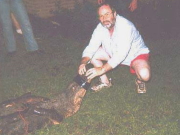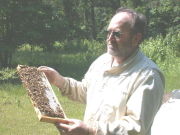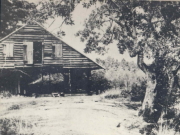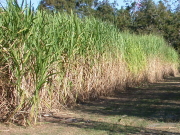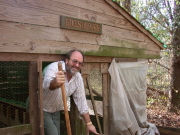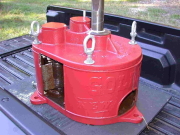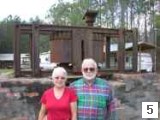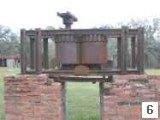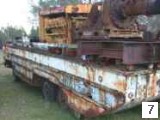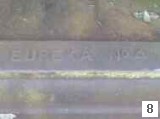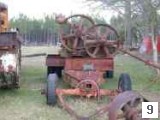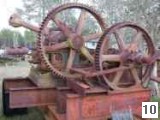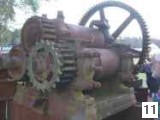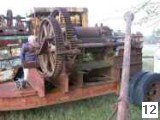Quitman Vignettes (Quitman, Georgia)
The impetus for my foray into Brooks County was the hope that I might locate the cane mill used by my father’s brother, Buren. Uncle Buren returned from the war and farmed with Uncle Cornelius for one year. Then, he moved into a house about 50 m from his parents-in-law and farmed with them. After his father-in-law, Mr. Robinson, passed away, Uncle Buren and his family moved into the big house with Mrs. Robinson and remained there until 1955, when they moved to Polk County, FL. The mill I sought was originally on a stand in the open a bit out from the big house. Now, it is in Quitman.
My connection in Brooks County was James Robinson, Uncle Buren’s wife’s nephew. The connection soon spread to James’ wife, Becky, and her brother, Alton Hamlin. Without these three, I would have been lost, and I am therefore much obliged to them. Although I did not achieve the goal I sought, I did gain other prizes, which I will share here.
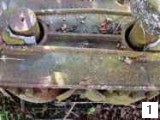 Morven, GA, is perhaps 15
miles north and slightly east of Quitman, where at least three brands of cane
mills were manufactured (See Index ). A similar cane mill was manufactured in
Valdosta , which is about 10 miles southeast of Morven. I had been told that a
foundry in Morven also made cane mills, and I had been on the lookout for a
couple of years but with no luck. It was therefore a great pleasure to find one
(Slides 1 and 2) although it had been relegated to a junk heap. The inscription,
which one can partially make out in one of the photos, reads “Morven Fdy.
& Mach.” and elsewhere, Morven , GA, is indicated as the city of
origin. One notes that this mill is
Morven, GA, is perhaps 15
miles north and slightly east of Quitman, where at least three brands of cane
mills were manufactured (See Index ). A similar cane mill was manufactured in
Valdosta , which is about 10 miles southeast of Morven. I had been told that a
foundry in Morven also made cane mills, and I had been on the lookout for a
couple of years but with no luck. It was therefore a great pleasure to find one
(Slides 1 and 2) although it had been relegated to a junk heap. The inscription,
which one can partially make out in one of the photos, reads “Morven Fdy.
& Mach.” and elsewhere, Morven , GA, is indicated as the city of
origin. One notes that this mill is 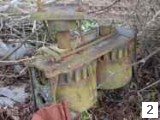 similar to the other open
two-roller mills mentioned above.
similar to the other open
two-roller mills mentioned above.
The elderly owner of the mill, Mr. Marion Dukes, is like many of us-he has a
lifetime of projects planned. When I visited, he was laying blocks for a spillway
while he discussed plans of making syrup.
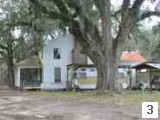 Cessna Hunt Club occupies a plantation
house that was constructed in 1837 on a stagecoach line (Slide
3). Although I know it is all too easy to gloss over the harsh realities of
life on the frontier, it is nevertheless fun and harmless to take a flight of
fancy, and the magnolia-lined avenue (Slide
4) makes it easy, too.
Cessna Hunt Club occupies a plantation
house that was constructed in 1837 on a stagecoach line (Slide
3). Although I know it is all too easy to gloss over the harsh realities of
life on the frontier, it is nevertheless fun and harmless to take a flight of
fancy, and the magnolia-lined avenue (Slide
4) makes it easy, too.
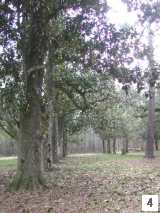 For the sake of readers who have
not benefited from a South-Georgia upbringing, it might pay to make a comment
about the word plantation. For many, GWTW’s Tara or the like inspires the
image evoked by this word. Indeed, these vast agribusinesses with their peculiar society that brandished pride and distorted
chivalry did punctuate the South from colonial times in the east, exemplified by
Jefferson’s Monticello, to ante bellum days in the west, exemplified by H.B. Stowe’s dreaded sugar cane plantations.
I am pleased to recommend the family letters of the venerable Reverend Charles
Colcock Jones to anyone who seeks a personal and even endearing view of this
institution. Later, wealthy industrialists from the North bought large tracks of
land in areas of the South such as Thomasville, GA, and they were and are called
plantations. The main commodities they produced were opulence and sport, rarely
row crops. But in the context of the times mentioned, the early 19th century, a
plantation merely meant a farm, or even a single field. Thus, Bartram, the first
English-speaking naturalist to come into the Deep South, referred to the single
communal plantation of an Indian village, and to a farm on which a
“mansion-house . . . overlooks . . . extensive and well cultivated
plantations of Indian corn, rice, wheat, oats, indigo, . . . [sweet
potato].” (Bartram also described a field of sugar cane, of interest, but
not particularly relevant here.) In addition to the caution against applying the
present connotation of the word plantation to descriptions of that era, I wish to
note that large southern areas had few or no Hollywood-style plantations. That
was the case in the southern part of Tallahassee’s Leon County, the
plantation of Prince Murat (Napolean’s nephew) being an exception. It was
also true in Berrien County, GA, where the families of three of my grandparents
were established by 1850. But, I digress . . . .
For the sake of readers who have
not benefited from a South-Georgia upbringing, it might pay to make a comment
about the word plantation. For many, GWTW’s Tara or the like inspires the
image evoked by this word. Indeed, these vast agribusinesses with their peculiar society that brandished pride and distorted
chivalry did punctuate the South from colonial times in the east, exemplified by
Jefferson’s Monticello, to ante bellum days in the west, exemplified by H.B. Stowe’s dreaded sugar cane plantations.
I am pleased to recommend the family letters of the venerable Reverend Charles
Colcock Jones to anyone who seeks a personal and even endearing view of this
institution. Later, wealthy industrialists from the North bought large tracks of
land in areas of the South such as Thomasville, GA, and they were and are called
plantations. The main commodities they produced were opulence and sport, rarely
row crops. But in the context of the times mentioned, the early 19th century, a
plantation merely meant a farm, or even a single field. Thus, Bartram, the first
English-speaking naturalist to come into the Deep South, referred to the single
communal plantation of an Indian village, and to a farm on which a
“mansion-house . . . overlooks . . . extensive and well cultivated
plantations of Indian corn, rice, wheat, oats, indigo, . . . [sweet
potato].” (Bartram also described a field of sugar cane, of interest, but
not particularly relevant here.) In addition to the caution against applying the
present connotation of the word plantation to descriptions of that era, I wish to
note that large southern areas had few or no Hollywood-style plantations. That
was the case in the southern part of Tallahassee’s Leon County, the
plantation of Prince Murat (Napolean’s nephew) being an exception. It was
also true in Berrien County, GA, where the families of three of my grandparents
were established by 1850. But, I digress . . . .
The large two-roller mill must have been the center of a sizeable syrup operation sometime in the past. James and Becky Robinson are shown on the feed side of mill (Slide 5) and give perspective to the 18-inch rollers, which are seen better from the discharge side (Slide 6). Although I climbed all over this mill, I found no inscriptions that might reveal its origins.
Mr. Walter Lewis, Jr., is a, well, . . . er, . . . collector. To make this point, I had acres to choose from, but decided simply to photograph a WWII DUKW next to the mill (Slide 7). It didn’t hurt that a large stationary engine and pump were piled into the craft!
The nameplate of a very large mill, a Blymyer Eureka # 4 is shown first (Slide 8) and several other photographs (Slides 9, 10, 11, and,12) show different views of the mill, some of its parts being on the ground. James’ head provides perspective for the size of this mill.
